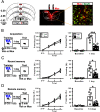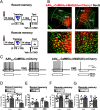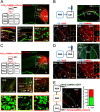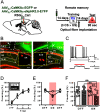Distinct Contribution of Granular and Agranular Subdivisions of the Retrosplenial Cortex to Remote Contextual Fear Memory Retrieval
- PMID: 34876468
- PMCID: PMC8808736
- DOI: 10.1523/JNEUROSCI.1303-21.2021
Distinct Contribution of Granular and Agranular Subdivisions of the Retrosplenial Cortex to Remote Contextual Fear Memory Retrieval
Abstract
The retrieval of recent and remote memories are thought to rely on distinct brain circuits and mechanisms. The retrosplenial cortex (RSC) is robustly activated during the retrieval of remotely acquired contextual fear memories (CFMs), but the contribution of particular subdivisions [granular (RSG) vs agranular retrosplenial area (RSA)] and the circuit mechanisms through which they interact to retrieve remote memories remain unexplored. In this study, using both anterograde and retrograde viral tracing approaches, we identified excitatory projections from layer 5 pyramidal neurons of the RSG to the CA1 stratum radiatum/lacunosum-moleculare of the dorsal hippocampus and the superficial layers of the RSA in male mice. We found that chemogenetic or optogenetic inhibition of the RSG-to-CA1, but not the RSG-to-RSA, pathway selectively impairs the retrieval of remote CFMs. Collectively, our results uncover a specific role for the RSG in remote CFM recall and provide circuit evidence that RSG-mediated remote CFM retrieval relies on direct RSG-to-CA1 connectivity. The present study provides a better understanding of brain circuit mechanisms underlying the retrieval of remote CFMs and may help guide the development of therapeutic strategies to attenuate remote traumatic memories that lead to mental health issues such as post-traumatic stress disorder.SIGNIFICANCE STATEMENT The RSC is implicated in contextual information processing and remote recall. However, how different subdivisions of the RSC and circuit mechanisms through which they interact to underlie remote memory recall remain unexplored. This study shows that granular subdivision of the RSC and its input to hippocampal area CA1 contributes to the retrieval of remote contextual fear memories. Our results support the hypothesis that the RSC and hippocampus require each other to preserve fear memories and may provide a novel therapeutic avenue to attenuate remote traumatic memories in patients with post-traumatic stress disorder.
Keywords: CA1; agranular retrosplenial cortex; contextual fear memory; granular retrosplenial cortex; memory retrieval; remote memory.
Copyright © 2022 the authors.
Figures














Similar articles
-
Analysis of coherent activity between retrosplenial cortex, hippocampus, thalamus, and anterior cingulate cortex during retrieval of recent and remote context fear memory.Neurobiol Learn Mem. 2016 Jan;127:93-101. doi: 10.1016/j.nlm.2015.11.019. Epub 2015 Dec 9. Neurobiol Learn Mem. 2016. PMID: 26691782 Free PMC article.
-
Fear-context association during memory retrieval requires input from granular to dysgranular retrosplenial cortex.Neurobiol Learn Mem. 2019 Sep;163:107036. doi: 10.1016/j.nlm.2019.107036. Epub 2019 Jun 12. Neurobiol Learn Mem. 2019. PMID: 31201928
-
NMDA receptors in retrosplenial cortex are necessary for retrieval of recent and remote context fear memory.J Neurosci. 2011 Aug 10;31(32):11655-9. doi: 10.1523/JNEUROSCI.2107-11.2011. J Neurosci. 2011. PMID: 21832195 Free PMC article.
-
Role of retrosplenial cortex in processing stress-related context memories.Behav Neurosci. 2018 Oct;132(5):388-395. doi: 10.1037/bne0000223. Epub 2018 Jun 7. Behav Neurosci. 2018. PMID: 29878804 Free PMC article. Review.
-
Retrosplenial cortex and its role in cue-specific learning and memory.Neurosci Biobehav Rev. 2019 Dec;107:713-728. doi: 10.1016/j.neubiorev.2019.04.016. Epub 2019 May 2. Neurosci Biobehav Rev. 2019. PMID: 31055014 Free PMC article. Review.
Cited by
-
Oxytocin signaling in the ventral tegmental area mediates social isolation-induced craving for social interaction.J Biomed Sci. 2025 Mar 17;32(1):37. doi: 10.1186/s12929-025-01130-0. J Biomed Sci. 2025. PMID: 40098181 Free PMC article.
-
A new map of the rat isocortex and proisocortex: cytoarchitecture and M2 receptor distribution patterns.Brain Struct Funct. 2024 Nov;229(8):1795-1822. doi: 10.1007/s00429-023-02654-7. Epub 2023 Jun 15. Brain Struct Funct. 2024. PMID: 37318645 Free PMC article.
-
Oxytocin treatment rescues irritability-like behavior in Cc2d1a conditional knockout mice.Neuropsychopharmacology. 2024 Oct;49(11):1792-1802. doi: 10.1038/s41386-024-01920-4. Epub 2024 Jul 16. Neuropsychopharmacology. 2024. PMID: 39014123
-
Brain-wide screen of prelimbic cortex inputs reveals a functional shift during early fear memory consolidation.Elife. 2022 Jul 15;11:e78542. doi: 10.7554/eLife.78542. Elife. 2022. PMID: 35838139 Free PMC article.
-
Unique Transcriptomic Cell Types of the Granular Retrosplenial Cortex are Preserved Across Mice and Rats Despite Dramatic Changes in Key Marker Genes.bioRxiv [Preprint]. 2024 Sep 17:2024.09.17.613545. doi: 10.1101/2024.09.17.613545. bioRxiv. 2024. PMID: 39345493 Free PMC article. Preprint.
References
Publication types
MeSH terms
LinkOut - more resources
Full Text Sources
Molecular Biology Databases
Research Materials
Miscellaneous
